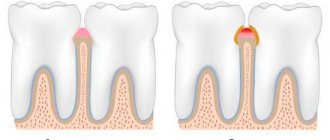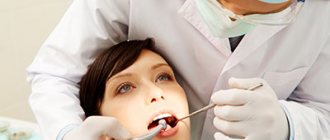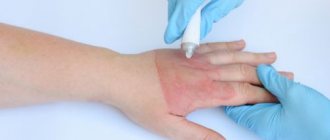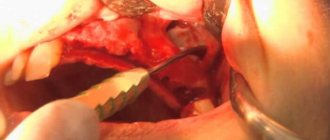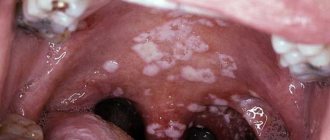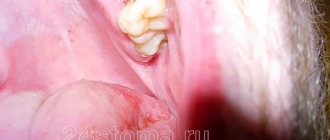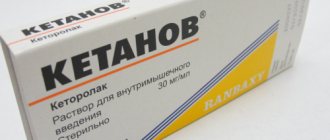Xerostomia is a feeling of constant dryness in the mouth caused by insufficient salivation. It is also accompanied by a burning sensation and dryness of the tongue and throat, problems with chewing and swallowing food, a metallic taste in the mouth and difficulty speaking.
Xerostomia can be either a symptom of an underlying serious illness (HIV, diabetes mellitus, Parkinson's disease, cancer), or a consequence of previous surgical procedures (for example, removal of the salivary glands), drug therapy, radiation therapy or chemotherapy.
Saliva is a lubricant that facilitates the grinding and processing of food, and also has an anti-inflammatory effect, it remineralizes tooth enamel and neutralizes the negative effects of acids contained in food on the surface of the teeth. That is why xerostomia is a serious problem that requires comprehensive and immediate treatment.
Xerostomia
Xerostomia (ICD code 10 - K 11.7) is pathological dryness in the oral cavity, caused by a decrease or complete cessation of salivation. The name of the concept in Latin, Xerostomia, comes from the Greek xero- (dryness) + -stoma (mouth). This is not a separate disease, but a symptom associated with another pathological process. Xerostomia is manifested by perversion of taste sensitivity and distortion of sensations in the oral cavity.
Specialists from the Yanino-1 and Vsevolozhsk branches of the West Dental family dentistry clinic will help identify the cause of this symptom and determine the specific treatment for all signs and pathological conditions. To do this, doctors have all the necessary high-tech equipment and sterilized instruments.
What can cause salivary gland hypotension?
The causes of the disease are different, but most often it acts as a concomitant factor of another ailment, including in the oral cavity:
Constant dry mouth is often experienced by older people who take a large number of medications, especially their combinations. In this case, the disease acts as a side factor.
Dry mouth often plagues hypertensive patients, diabetics, and people with anemia associated with iron deficiency. It accompanies HIV infection, arthritis, and cystic fibrosis. The disease also develops against the background of autoimmune dysfunction in Shane's syndrome. Any virus (infectious mumps, for example) that enters the bloodstream or innervation system can become a catalyst for the development of xerostomia.
It is short-term in nature during moments of dehydration (fever, serious burns, significant blood loss, uncontrollable vomiting, diarrhea). Symptoms are pronounced in oncological diseases of the head and neck during radiation procedures.
Often, salivary dystonia occurs due to various intoxications of the central nervous system, brain injuries or tabes dorsalis.
After surgical removal of the salivary gland, the disease becomes irreversibly chronic. Therefore, the oral cavity requires constant additional hydration with special means.
With senile muscle weakness, when the lower jaw rises with difficulty, sleeping with the mouth open leads to xerostomia up to complete atrophy of the salivary gland.
In healthy people, symptoms may occur with problems associated with the nasal septum or the presence of polyps on the nasal mucosa. Frequent rinsing, especially with aggressive ingredients, will also result in a deficiency of saliva.
Causes
Many reasons lead to xerostomia, but the most basic is the use of medications, the secondary manifestation of which is dryness of the mucous membranes of the oral cavity. For temporary use, this is a harmless effect, but for a long course, an alternative should be chosen.
The main list of drugs that cause xerostomia, as one of the possible side symptoms:
- painkillers;
- muscle relaxants;
- bronchodilators;
- anticonvulsants and antitumor;
- lowering pressure;
- diuretics;
- tranquilizers.
In addition to medications in the oral cavity, xerostomia is caused by:
- diabetes;
- hypertension;
- iron deficiency;
- HIV infection;
- rheumatism;
- dysfunction of the thyroid gland;
- taking multiple medications at once;
- elderly age;
- radiation therapy;
- Sjögren's syndrome - dryness of all mucous membranes in the body.
When the nasal passages are blocked and there is a runny nose or a decrease in the tone of the soft palate, breathing at night occurs through the mouth, which is why the mucous membranes dry out in the morning. A temporary phenomenon can occur with any dehydration of the body: diarrhea, vomiting, fever, low fluid intake.
Frequent rinsing of the mouth with concentrated solutions creates all the conditions for the development of atrophy of the salivary glands and dryness of the mucous membranes.
Xerostomia: causes
As a rule, the causes of xerostomia are “hidden” not in the salivary glands themselves, but in a disease of any system of the body or a general infectious disease. This condition is mainly caused by:
- Infectious diseases: tonsillitis, tuberculosis, HIV, tonsillitis, mumps (aka “mumps”, an infectious disease of the parotid salivary glands).
- Hypertension or severe iron deficiency anemia.
- Rheumatoid arthritis, as well as some diseases of the endocrine system: thyrotoxicosis (occurs when the thyroid gland is damaged), diabetes mellitus (develops when the function of the pancreas is impaired), sialadenitis (inflammation of the salivary glands themselves).
- Head or neck injuries, constant mouth breathing due to injury to the nose or the formation of polyps in the sinuses.
- Long-term use of certain groups of medications, dehydration with prolonged fever or vomiting.
- Bad habits: drinking alcohol, smoking, drug use.
The functions of the salivary glands are not necessarily impaired in all of these diseases and conditions, but if a person has xerostomia, they will be considered as possible causes.
Classification
There are 3 stages:
- The mildest stage, in which the submandibular and parotid salivary glands function, and saliva is secreted normally. Xerostomia appears as a symptom of overwork or after a long conversation. Upon visual examination, the saliva is foamy and the mucous membrane is moist.
- The normal functioning of the salivary glands is disrupted and dryness becomes constant, diction becomes difficult. A person has difficulty eating dry food. On examination, the mucous membrane is slightly moisturized, pale and has some shine.
- At this stage, the salivary glands stop functioning. Patients pay attention to severe dryness and painful sensations of the mucous membrane. Erosive and ulcerative surfaces form in the mouth, all aggravated by stomatitis, glossitis, generalized caries and flaky lips.
Xerostomia: symptoms
This is a rather unpleasant condition that prevents you from living a full life, eating normally, and sometimes communicating normally. Symptoms of xerostomia are usually:
- Constant dry mouth, especially noticeable while eating. A person is always thirsty, and while eating, he washes down every bite of food, which does not contribute to normal digestion.
- General discomfort, sometimes itching of the oral mucosa.
- In some cases, swallowing becomes difficult, which is especially unpleasant since the patient needs to drink all the time.
- Bad breath, which appears due to the formation of bacterial plaque on the gums, teeth, tongue, and mucous membranes of the cheeks (usually such plaque is washed out to some extent by saliva).
- Red rough tongue, pale pink mucous membranes of the mouth, cracks in the corners of the lips, dry and flaky skin on the lips. These symptoms appear and get worse gradually.
- Changes in taste sensations: people stop feeling the usual taste of foods, perceiving it pervertedly.
Since saliva does not wash away bacterial plaque and the acid-base balance in the mouth is disturbed, favorable conditions are created for the reproduction and activity of pathogenic microbes. Because of this, xerostomia can be complicated over time by stomatitis, gingivitis, and in advanced cases, periodontitis.
Diagnostic measures
Diagnosis is an important step in further eliminating symptoms and curing the pathological condition. The doctor begins by collecting anamnesis and understanding what medications the patient is taking. Then an ultrasound of the salivary glands and sialography are performed. If the underlying cause of xerostomia is associated with taking a large variety of medications, then its treatment will be simple. However, after courses of radiation, it is difficult, and sometimes impossible, to fully recover. Because this technique maximally suppresses the functioning of the gland and salivation.
Diagnosis of xerostomia
Xerostomia has pronounced symptoms, on the basis of which a diagnosis can be easily made, namely:
- feeling of dryness and stickiness in the mouth;
- small volume of saliva secreted;
- the consistency of saliva is thick and stretchy;
- sore throat;
- roughness, roughness and burning sensation on the tongue;
- unpleasant odor from the mouth;
- pain during talking and eating;
- disturbance of taste sensations.
In addition to interviewing the patient and external examination, the following procedures are performed to determine the degree of xerostomia:
- Sialometry is a procedure during which the amount of saliva secreted is measured. Citric acid is used as a saliva production stimulator.
- Sialography is an x-ray of the salivary glands and ducts using a contrast method. Used as a differential diagnosis to distinguish xerostomia from salivary gland stones.
- Biopsy is the collection of tissue samples from the salivary glands. It is also used as a differential diagnosis to distinguish xerostomia from malignant tumors.
Treatment
The West Dental clinic will be able to determine how to treat xerostomia and the exact specifics of the pathological process. The disease can only be eliminated gradually by eliminating all provoking signs. Only a comprehensive approach can treat the disease, and for this, accurate diagnostic measures are important. Temporary discomfort is eliminated quickly, and the chronicity of the process is minimized by precise therapy.
To achieve a stable and favorable result, the patient must actively cooperate with the treating doctor.
Recommended:
- maintain excellent oral hygiene;
- drink plenty of fluids;
- exclude salty, spicy and sweet foods;
- to refuse from bad habits;
- use saliva-replacing rinses.
It is also possible to use folk remedies at home:
- rosehip decoctions;
- lingonberry and cranberry juices;
- infusions of chamomile, sage or calendula;
- olive oil;
- herbal sprays and gels.
Treatment and prevention
Treatment is prescribed by a dentist. Most often these are preparations that imitate saliva: gels, pastes that act as a lubricant. If the illness manifests itself situationally, it is recommended to drink water more often, suck on sugar-free candies, and take breaks in speech.
| The sooner the problem is detected, the faster, cheaper, and more painlessly it will be treated. |
To prevent this problem from leading to the development of other diseases, you need to take a very responsible approach to daily oral hygiene. Brush your teeth twice a day with a soft-bristled brush and toothpaste containing fluoride. Use brushes, dental floss, and then mouthwash.
Back
Prevention
A standard preventative measure is to drink more fluid; for an adult, the norm is 1.5-2 liters per day.
- It is necessary to stimulate constant salivation. You can suck on lollipops, chewing gum and sugar-free sweets;
- Elimination of bad habits. Minimize the consumption of alcoholic beverages and smoking. Complete refusal is preferable;
- Eat plenty of fruits and vegetables. They prevent dryness and bitterness in the mouth;
- Rinse your mouth in the morning and evening with alcohol-free solutions;
- Avoiding dehydrated foods that are high in salt.
Water and chewing gum will help
First of all, you need to see a dentist who will check the functioning of your salivary glands. Also, with dry mouth, you can contact an ENT specialist, endocrinologist, gastroenterologist and neurologist, since xerostomia can be a consequence of diseases in their profile.
It is precisely because dry mouth is not a self-sufficient disease, but a symptom, that its treatment can be difficult. Doctors usually recommend the following methods:
- First of all, you need to treat the underlying disease. It is advisable to eliminate or reduce medications with the side effect of dryness.
- Special saliva substitutes will help moisturize the mucous membrane. They come in the form of gels, sprays, oils.
- A patient with dry mouth syndrome is recommended to drink more water, but not in one gulp, but in small sips.
- Chewing gum or lollipops will not help get rid of xerostomia, but they will temporarily alleviate the situation, as they promote salivation. However, it is better not to get carried away with sweet tastes, so as not to provoke the appearance of caries.
To quickly get rid of the disease, you need to give up not only sweets (especially at night), but also dry, spicy, too cold or, conversely, hot food. In addition, alcohol and smoking should be avoided, as these bad habits also “dry” the mucous membrane.
As a preventive measure and in the early stages, it is advisable to install an air humidifier in the room, as well as carefully monitor oral hygiene: add the use of dental floss and rinses to traditional brushing of teeth with paste. In addition, if you have problems with salivation, you should visit the dentist more often and have your teeth “cleaned” of plaque.
The iOrtho clinic network provides high-quality services for correcting malocclusion with Invisalign aligners, sign up for a consultation now!
How is oral xerostomia treated?
People of all ages turn to doctors with the question of how to relieve dry mouth. Before starting treatment for xerostomia, the specialist must determine the patient’s individual indications and exclude contraindications. Long-term drug therapy is required in rare cases. Usually, to improve the condition and eliminate dry mouth, dentists advise starting with correcting your diet and eating habits.
- To boost saliva production, drink more water.
- Try the so-called chewing diet, with a predominance of foods that require thorough chewing in your diet.
- There should be as little soft food as possible.
- Eliminate salty, sweet, too spicy foods, as well as caffeinated drinks and alcohol from the menu.
- To create an optimal temperature regime, it is advisable to always have a humidifier running at home.
- ethnoscience
It is recommended to treat dryness with folk remedies in the absence of other accompanying symptoms. If you are not allergic, you can chew parsley, dill and celery throughout the day. Citrus juices, green tea, infusions based on ginger, peppermint, and aloe juice are good for stimulating salivation. There are many tasty and healthy foods, but if you have xerostomia, you should use them with caution. You can always find out how to remove dry mouth using folk remedies without harming the body at an appointment with a doctor.
Treatment methods
Treatment of sialadenosis is a multi-step process. The main condition is effective therapy for the underlying or concomitant disease, although this will not help solve the problem completely. Symptomatic therapy is possible using novocaine blockades. Physiotherapy will help cope with unpleasant symptoms; electrophoresis, galvanization, magnetic and laser therapy are widely used. The impact is carried out on the area of the cervical nerve tissue in order to improve the conductivity of impulses.
Drug therapy consists of the use of vitamin E, drugs to stimulate salivation, as well as colloidal solutions to correct blood viscosity and improve blood flow in small blood vessels. Surgical treatment may be indicated in the absence of a positive response to conservative therapy. It consists of partial or complete removal of the salivary gland or its duct.
How to make artificial saliva at home
Simultaneously with treatment, the condition of a person for whom a lack of saliva causes inconvenience and worsens health should be alleviated. To minimize oral dryness, doctors recommend using saliva substitutes in gel or aerosol format [3]. However, you can prepare artificial saliva yourself.
An important component of the replacement fluid is sea salt. The fact is that its aqueous solution with a concentration of 1.5–2% is pH neutral and is similar in ionic composition to blood plasma. The required amount of salt per glass of water is half a teaspoon (3-4 grams). One egg white is also added to the solution and mixed thoroughly. Rinse the mouth and throat with the resulting mixture at least 4 times a day or more often if drying occurs faster. To achieve sustainable results, the course must last at least a month [2].
Therapy to stimulate salivation
In a number of diseases, dry mouth persists for a long time, and sometimes for life. However, you can force the salivary glands to work more productively by periodically exerting an irritating, stimulating effect on them.
- Drug stimulation. Taking medications with a salivary effect as prescribed by a doctor.
- Local stimulants: chewing gum, sour candies. Their main drawback is the short duration of the result. In addition, regular consumption can be harmful to health. For example, citric acid in sour candies irritates the mucous membranes, and sugar provokes caries .
- Physiotherapeutic methods: targeted radiation of a helium-neon laser, shallow massage of the salivary glands, magnetic therapy, electrophoresis, ozokerite and therapeutic mud applications. After their exposure, the salivary glands fully or partially restore secretory activity [1, 2].
Dry mouth is caused by various etiologies, and it is impossible to make a correct diagnosis on your own. Therefore, it is very important to see a doctor as soon as possible, even if the problem only bothers you periodically. Without timely measures, your health will inevitably worsen. In addition, delay increases the risk of related problems - including the rapid development of caries, due to which you will have to become a regular patient of the dentist.
List of sources
- Pozdnyakova A. A. Features of diagnosis, clinical manifestations and correction of xerostomic syndrome in patients with diseases of the oral mucosa: dissertation. Ph.D. honey. Sciences: 01/14/14 - dentistry. Perm, 2014. // URL: https://www.psma.ru/index.php?option=com_mtree&task=att_download&link_id=22&cf_id=24 (date accessed 08/28/2020).
- Dedova L.N., Gorodetskaya O.S. Saliva: a modern view of a dentist // Belarusian State Medical University, Minsk. // URL: https://www.bsmu.by/files/475b948dcf7e198bfc2afbb9281a237f/ (accessed 08/28/2020).
- Kryukov A. I., Kunelskaya N. L., Tsarapkin G. Yu., Izotova G. N., Tovmasyan A. S., Kiseleva O. A. Symptomatic therapy of temporary xerostomia in patients after surgical interventions on the structures of the nasal cavity and pharynx // Medical advice. 2014. No. 1. P. 40–44. // URL: https://www.med-sovet.pro/jour/article/download/526/526 (accessed 08/28/2020).
